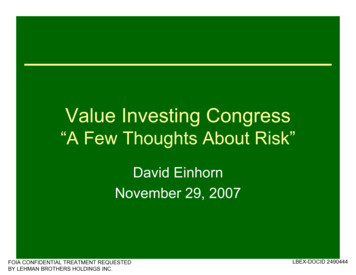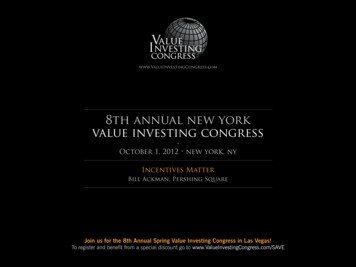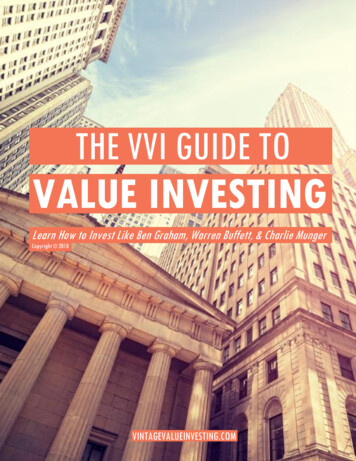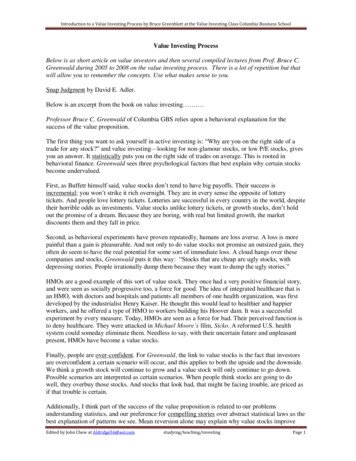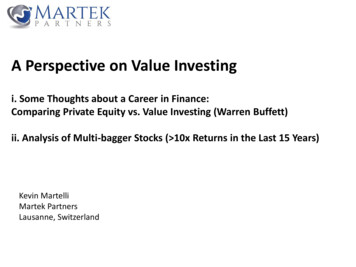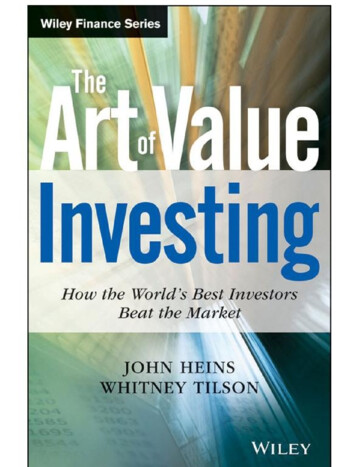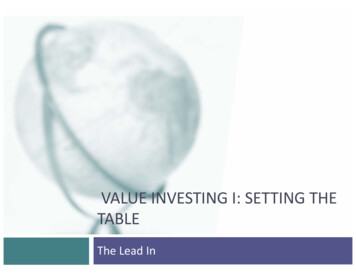
Transcription
VALUE INVESTING I: SETTING THETABLEThe Lead In
Value Investing: The Winner? One of the classes that I teach is on investment philosophies,where I begin by describing an investment philosophy as a set ofbeliefs about how markets work (and sometimes don't) which leadto investment strategies designed to take advantage of marketmistakes.Unlike some, I don't believe that there is a single "best"philosophy, since the best investment philosophy for you is the onethat best fits you as a person. I start with technical analysis andcharting, move on to value investing, then on to growth investing,and end with information trading and arbitrage.The most common pushback that I get is from old-time valueinvestors, arguing that there is no debate, since value investing isthe only guaranteed way of winning over the long term.2
Three Questions What is value investing and what do you need to doto be called a value investor?There is no consensus even among value investors, otherthan that value investing is buying cheap companies. Within value investing, there are multiple strands, withvery different views of how markets work (or do not). Where does this certitude that value investing is the"winningest" philosophy come from? Is it deserved?How long is the long term, and is it guaranteed thatvalue investing wins?3
What is value investing? Lazy Value Investing: Let's start with the easiest and most simplisticdefinition, and the one that many data services and academics continueto use, simply because it is quantifiable and convenient, and that is tobase whether you are a value or growth investor on whether the stocksyou buy trade at low or high multiples of earnings or book value.Cerebral Value Investing: Good value investing starts by looking atcheapness (PE and PBV) but also includes other criteria such as goodmanagement, solid moats or competitive advantages and otherqualitative factors.Big Data Value Investing: Closely related to cerebral value investing inphilosophy, investors start with the conventional measures of cheapness(low PE and low PBV) but also look for additional criteria that hasseparated good investments from bad ones. Those criteria are found byporing over the data and looking at historical returns, a path made moreaccessible by access to huge databases and powerful statistical tools.4
A different categorization Passive Value Investing: In passive value investing, you screen for the best stocksusing criteria that you believe will improve your odds. Once you buy these stocks,you are asked to be patient, and in some cases, to just buy and hold, and thatyour patience will pay off as higher returns and a more solid portfolio.Contrarian Value Investing: In contrarian value investing, you focus your investingenergies on companies that have seen steep drops in stock prices, with the beliefthat markets tend to overreact to news, and that corrections will occur, to deliverhigher returns, across the portfolio.Activist Value Investing: In activist value investing, you target companies that arenot only cheap but badly run, and then expend resources (and you need aconsiderable amount of those) to push for change, either in managementpractices or in personnel. The payoff to activist value investing comes from activistinvestors being the catalysts for both price change in the near term, as marketsreact to their appearance, and to changes in how the company is run, in the longterm.Minimalist Value Investing: We have seen the rise of titled index funds and ETFs,where you start with an index fund or ETF, and tilt the fund/ETF by overweightingvalue stocks (high PE/PBV, for instance) and underweighting non-value stocks.5
A Financial Balance Sheet Perspective6
Value Investing Wins: The Story Roots When stock markets were in their infancy, investors faced two problems. The first was that there were almost no information disclosure requirements, and investors hadto work with whatever information they had on companies, or on rumors and stories.The second was that investors, more using to pricing bonds than stocks, drew on bond pricingmethods to evaluate stocks, giving rise to the practice of paying dividends (as replacements forcoupons).Ben Graham laid the foundations for modern value investing, by formalizing hisapproach to buying stocks and investing in 1934 in Security Analysis, a book thatreflected his definition of an investment as "one which thorough analysis,promises safety of principal and adequate return". Graham's subsequentlywrote The Intelligent Investor, where he elaborated his more developedphilosophy of value investing and developed a list of screens, built aroundobservable values, for finding under valued stocks.In 1938, John Burr Williams wrote The Theory of Investment Value, introducing thenotion of present value and discounted cash flow valuation.7
The story gets augmented. Buffett’s role Buffett, one of Graham’s students at Columbia University, startedan investment partnership, putting value investing into practice,with his own unique twists for his partners. He dissolved that partnership (famously) in 1969, arguing that given achoice between bending his investment philosophy and findinginvestments and not investing, he would choose the latter.These words, in his final letter to partners in May 1969, more than anyothers have cemented his status in value investing: "I just don't seeanything available that gives any reasonable hope of delivering such agood year and I have no desire to grope around, hoping to "get lucky" withother people's money.He did allow his partners a chance to receive shares in a strugglingtextile maker, Berkshire Hathaway, and the rest, as they say, ishistory, as Berkshire Hathaway morphed into an insurancecompany, with an embedded closed end mutual fund, investing inboth public and some private businesses, run by Buffett.8
And the Berkshire Hathaway payoff9
Value Investing: The Numbers Roots If all that value investing had for it were the stories of great valueinvestors and their exploits, it would not have the punch that itdoes today, without the help of a numbers strand, ironically drivenby the very academics that value investors hold in low esteem.The capital asset pricing model, despised by value investors, alsowas developed in 1964, and for much of the next 15 years, financialresearchers worked hard trying to test the model. To theirdisappointment, the model not only revealed clear weaknesses,but it consistently misestimated returns for classes of stock. In 1981, Rolf Banz published a paper, showing that smaller companies (interms of market capitalization) delivered much higher returns, afteradjusting for risk with the CAPM, than larger companies.Over the rest of the 1980s, researchers continued to find other companycharacteristics that seemed to be systematically related to returns, eventhough theory suggested that they should not.10
The Fama-French Effect11
With different interpretations. It is a proxy for missed risk: In their 1992 paper, Fama and French arguedthat companies that trade at low price to book ratios are more likely to bedistressed and that our risk and return models were not doing anadequate job of capturing that risk. They and others who have advancedthe same type of argument would argue that rather than be a stamp ofapproval for value investing, these studies indicate risks that may notshow up in near term returns or in traditional risk and return models buteventually will manifest themselves and cleanse the excess returns. Putsimply, in their world, value investors will look like they are beating themarket, until these unseen risks show up and mark down their portfolios.It is a sign of market inefficiency: During the 1980s, as behavioral financebecame more popular, academics also became more willing to accept andeven welcome the notion that markets make systematic mistakes and thatinvestors less susceptible to these behavioral quirks could take advantageof these mistakes. For these researchers, the findings that low price tobook stocks were being priced to earn higher returns gave rise to theoriesof how investor irrationalities could explain these returns.12
The End Result When valuing companies, I talk about how value is a bridgebetween stories and numbers, and how the very best andmost valuable companies represent an uncommon mix ofstrong stories backed up by strong numbers.In the realm of investment philosophies, value investing hashad that unique mix work in its favor, with stories of valueinvestors and their winning stocks backed up by numbers onhow well value investing does, relative to other philosophies.It is therefore no surprise that many investors, when asked todescribe their investment philosophies, describe themselvesas value investors, more because it has been historicallyviewed as not just a winning philosophy, but one withintellectual and academic backing for its successes than dueto any loyalty or adherence to its core principles.13
7 Value Investing Wins: The Story Roots When stock markets were in their infancy, investors faced two problems. The first was that there were almost no information disclosure requirements, and investors had to work with whatever information they had on companies, or on rumors and stories. The second was that investors, more using to pricing bonds than stocks, drew on bond pricing





